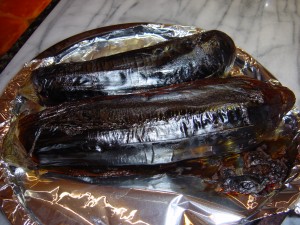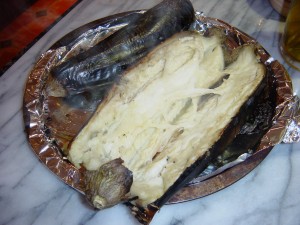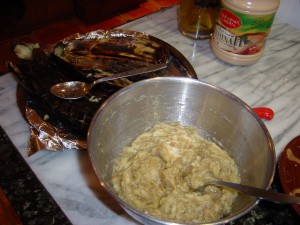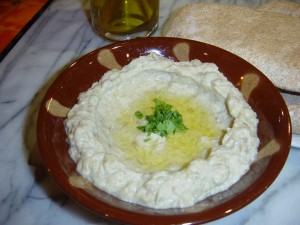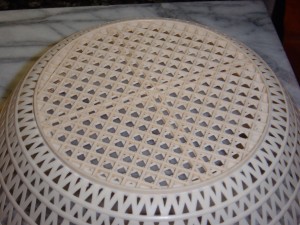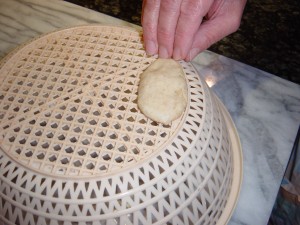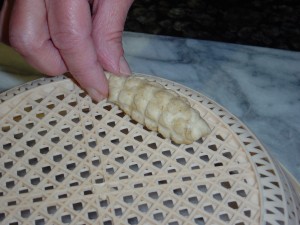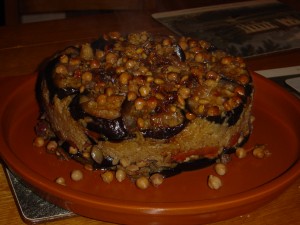I think the taste for this dish comes from using fresh fish stock, (not cubes) to which caramelised onions are added which in turn gives it a special aroma. Sayyadiyeh is usually served with a flavoured tahini sauce which I include in the recipe.
For the main dish, you could use any white firm meaty fish such as cod or haddock.
Serves 4.
Ingredients
For the fish stock.
· 450 g/ 1lb fish trimmings including skin and bones
· Enough tap water to cover the fish about 1 litre/ 2 pints
· 1 medium onion roughly chopped
· 3 sticks of celery washed and roughly chopped
· 2 carrots washed and roughly chopped
· Large handful of chopped parsley including stems
· 1 bay leaf
· Salt and pepper
For the dish
· Vegetable oil
· 500 g/ 1lb 2 oz Cod or Haddock fillets or any other firm white fish
· 5 medium onions thinly sliced
· 225 g/ 8 oz rice soaked for half an hour before the cooking
· ½ tsp of each ground cinnamon and ground coriander
· 1 tsp ground cumin
· Salt and freshly milled black pepper
· A pinch of saffron
· 2 tbsp pine nuts (optional)
· 1 lemon quartered
For the hot tahini sauce
· 200 ml/ 7 fl oz tahini paste
· 200 ml/ 7 fl oz lemon juice
· 200 ml/ 7 fl oz water
· 4 fat cloves of garlic peeled
· 1 tsp ground coriander
· 2 green chillies, or more if you like it hotter, very finely chopped
· 3 tbsp fresh coriander chopped
· Salt
· 1 tbsp olive oil
Method
To make the stock.
1. Rinse the fish trimmings and bones then put with the other remaining stock ingredients in a large saucepan, cover with water and using high heat, bring to boil. Remove the scum that forms then lower the heat, cover and let it simmer for 45 minutes, checking from time to time. Let it cool slightly before straining and reserving the stock. You need about 500 ml/ 17 fl oz to cook with. You can freeze any excess stock.
To prepare the main dish.
2. Rinse the fish under a cold water tap, pat dry with kitchen paper and lay skin down in a buttered oven proof dish. Sprinkle a little lemon juice and brush the fish generously with vegetable oil, season with salt and pepper. Cover and pop it in a 200°C/ 400°F pre-heated oven, bake for 10-15 minutes, then uncover, brush the top with the juices. On a medium to high setting, grill the fish for 3 minutes to give it a crispy texture. Let it cool before flaking it into chunky pieces. Keep warm.
3. Heat up about 2 tbsp of vegetable oil in a large to medium frying pan, fry the onions until caramelised, they should turn dark brown but not be burnt. Remove with a slotted spoon and transfer onto a plate layered with a kitchen paper to drain excess oil. Meanwhile, you can soak the rice.
4. Add half of the caramelised onion to the stock and bring back to the boil then simmer for about 10 minutes. Fish out the onions with a slotted spoon then liquidise and return to the stock. If at that stage, you find the sauce is too thick, thin it down with water. Now, return the mixture to the heat, season with the spices, taste and adjust if necessary.
5. Drain the rice then transfer into a medium saucepan, stir in a quarter of the chunky fish then add 500 ml / 17 fl oz of the stock, bring to the boil, cover then let it simmer for about 12-15 minutes until the rice has absorbed the liquid and cooked. Next, place the remaining cooked fish on top, cover for about 5 minutes before serving.
6. While the rice is cooking, grease lightly a small frying pan and toast the pine nuts until golden.
7. Transfer the rice-fish mixture onto a serving plate, scatter over the caramelised onions followed by the toasted pine nuts and serve at once with wedges of lemon and the Hot Tahini Sauce on the side.
To prepare the Hot Tahini Sauce.
-
Mix lemon juice with the tahini paste and gradually add the water with ½ tsp of salt, You’ll have a lumpy paste to start, but don’t worry, keep stirring with the spoon until all the ingredients are thoroughly combined and the sauce has reached a creamy consistency. Taste and adjust if necessary.
-
Next, sprinkle the garlic with a pinch of salt and ground coriander and crush to a paste.
-
Heat up the oil in a medium sized saucepan. Stir in the garlic paste along with the fresh coriander and chillies, using a medium heat, cook for 2 minutes then add the tahini sauce, stir the whole mixture to help the flavours to develop. If you notice that the mixture is too thick, you can add some water. When it is about to boil, reduce the heat and simmer gently for five minutes, stirring occasionally. Pour into a heat proof jug and serve at once with the main dish.

